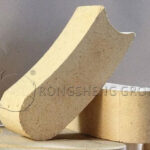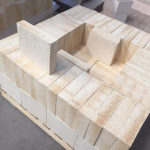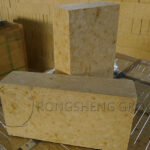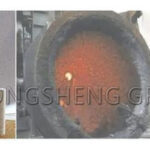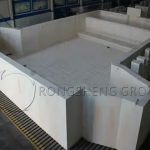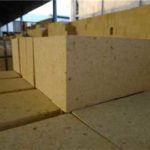High-alumina refractories are one of the most widely used material types in the refractory industry. Belonging to the aluminosilicate refractories family, high-alumina refractories include high-alumina refractory bricks and high-alumina monolithic materials. They are used in thermal kilns in downstream industries such as steel, cement, glass, and non-ferrous metals. Two key indicators are particularly important for high-alumina refractory bricks. RS High Alumina Refractory Bricks Manufacturer supplies high-quality refractory bricks, offering custom sizes and shapes. Contact RS Factory for free samples and quotations.

Two Key Indicators of High-Alumina Refractory Bricks
Compared to clay-based refractory bricks, the most prominent advantage of high-alumina refractory bricks lies in their high refractoriness and high load softening temperature, which are of utmost concern during procurement and use.
High Refractoriness
The refractoriness of alumina refractory bricks fluctuates widely, generally ranging from 1770 to 2000℃. It is primarily influenced by the Al2O3 content, increasing with increasing Al2O3 content. The refractoriness of high-alumina refractory bricks is also affected by the content and type of impurities, and is related to the mineral phase structure of the product.
High Load Softening Temperature
The initial deformation temperature of high-alumina refractory bricks under load softening is greater than 1400℃, and increases with increasing Al2O3 content. For products with an Al2O3 content of less than 71.8%, the load softening temperature depends on the ratio of mullite to liquid phase, increasing with increasing mullite content. The quantity and properties of the liquid phase have a significant impact on the load softening point. When the Al2O3 content is 71.8%–90%, the product is composed of mullite and corundum. With increasing Al2O3 content, the amount of glassy phase remains essentially unchanged; although corundum increases, mullite decreases, so the increase in softening temperature under load is not significant. When the Al2O3 content exceeds 90%, the amount of glassy phase decreases, and the softening temperature under load increases significantly. The relationship between Al2O3 content and softening temperature under load is shown in the diagram, increasing from 1630℃ with 90% Al2O3 to 1900℃ with 100% Al2O3.

Why do High-Alumina Bricks of the Same Material Have Different Prices?
High-alumina bricks of the same material have different prices, mainly due to differences in bulk density and shape. The quantity also significantly affects the price.
For example, LZ-75 refractory bricks can cost hundreds or even thousands of yuan more than standard-sized ones due to their special specifications and shapes. Standard-sized high-alumina bricks are used in large quantities, while irregularly shaped bricks are used in smaller quantities and have various shapes, resulting in prices several thousand yuan higher. Because irregular shapes are difficult to demold, they are harder to form during production, reducing the yield and increasing costs. Furthermore, the high cost of molds, coupled with the small quantity required (sometimes just a few bricks), increases labor and time costs for mold setup and replacement. Therefore, even high-alumina bricks of the same material can have different prices.
Additionally, even high-alumina bricks of the same material can have different prices depending on their required bulk density. If the load softening temperature also differs, the price difference is even greater. Taking high-alumina bricks with a 75% alumina content as an example, the price will increase if higher density and load-bearing capacity are required. Even with the same alumina content, higher physical properties will result in a higher price. Similarly, a lower iron content will increase the price.
In conclusion, the price of high-alumina bricks is not determined by a single indicator. The price depends on various physical properties, shape, quantity, and other factors.
Can High-Alumina Refractory Bricks be Watered After Leaving the Kiln?
High-alumina refractory bricks, especially those fresh from the kiln, should not be watered.
Some vendors, solely pursuing high weight and density, start watering the bricks immediately after they leave the kiln. This unscientific method of watering while the bricks are still warm will cause them to lose their compressive strength and performance.
This is because the refractory bricks still have a certain temperature after leaving the kiln, generally around 60 degrees Celsius, and sometimes exceeding 100 degrees Celsius in short tunnel kilns. Pouring tap water into these bricks while they are still warm will rapidly cool them down, affecting their thermal shock resistance. Therefore, never water high-alumina refractory bricks while they are still warm after leaving the kiln.
Can a small amount of water be applied to high-alumina refractory bricks after they have completely cooled down, i.e., during construction? It’s best not to add water. While the high-alumina bricks are no longer affected by temperature at this point, and adding water at a certain temperature won’t necessarily lower product quality, it’s still highly inappropriate.
Some construction teams might say that adding water is convenient in hot weather. However, the jointing material for high-alumina bricks, high-alumina refractory mortar, is mixed with water before use and is perfectly capable of bonding the bricks. It’s not about wetting the high-alumina bricks to facilitate bonding between them. Introducing a large amount of moisture during construction will pose challenges to kiln curing.
Therefore, high-alumina bricks should not be watered when they come out of the kiln. The temperature at this time will affect the performance of the refractory bricks and reduce their service life.

